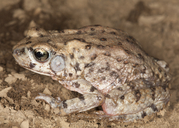|
Sclerophrys dodsoni (Boulenger, 1895)
Dodson's Toad, dufda 'a 'ilba | family: Bufonidae genus: Sclerophrys |
 © 2012 Frank Deschandol (1 of 2) |
|
|
|
Description The dorsum is olive gray with small black and light orange spots. Distinctive dark spots are also present below and slightly anterior to each eye. Limbs have dark bands, while ventral sides are primarily whitish. The male subgular sac is white. Juveniles are more brightly colored than their adult counterparts (Baha el Din 2006). Distribution and Habitat Country distribution from AmphibiaWeb's database: Djibouti, Egypt, Ethiopia, Somalia, Sudan
Bufo dodsoni regularly occurs in rocky wadis (valleys or dry riverbeds) in dry subdeserts with temporary or permanent water sources. It is generally found from sea level to 1800 meters above sea level (Baha el Din 2006). Life History, Abundance, Activity, and Special Behaviors The call is a single note that sounds like a dog's bark. Tadpole development is rapid, with metamorphosis occuring in six weeks, and full adult size requiring only about one year of development (Baha el Din 2006). In the Egyptian neighborhood of Gebel Elba, specimens have been found during winter and spring, in and near wells among rocks at night. Members of the species often sit in elevated positions on rocks and small boulders looking out for moving prey. In captivity, B. dodsoni feeds on relatively large prey. Juveniles, for instance, consume "pinkies" about half their own size. During periods of extended drought, individuals may retreat to higher elevations, for the higher relative humidity (Baha el Din 2006). Trends and Threats It occurs in Awash National Park in Ethiopia. It also occurs in the protected Gebel Elba area of Egypt. The area of largest population, Somalia, is not protected (Balletto et al. 2006). Possible reasons for amphibian decline Intensified agriculture or grazing
References
Baha El Din, S. (2006). A Guide to the Reptiles and Amphibians of Egypt. The American University in Cairo Press, Cairo. Balletto, E., Lanza, B., Largen, M., and Baha El Din, S. (2006). Bufo dodsoni. In: IUCN 2008. 2008 IUCN Red List of Threatened Species. www.iucnredlist.org. Downloaded on 24 April 2009. Originally submitted by: Taha Jabbar (first posted 2009-03-03) Edited by: Kellie Whittaker (2009-04-24) Species Account Citation: AmphibiaWeb 2009 Sclerophrys dodsoni: Dodson's Toad <https://amphibiaweb.org/species/163> University of California, Berkeley, CA, USA. Accessed Jun 4, 2025.
Feedback or comments about this page.
Citation: AmphibiaWeb. 2025. <https://amphibiaweb.org> University of California, Berkeley, CA, USA. Accessed 4 Jun 2025. AmphibiaWeb's policy on data use. |


 Map of Life
Map of Life